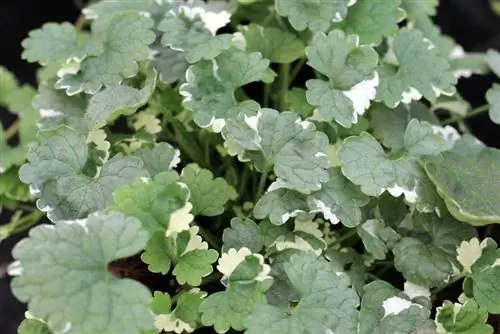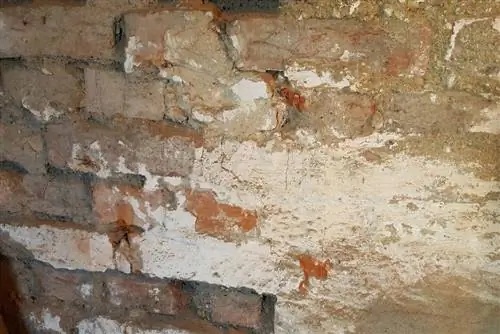- Author admin [email protected].
- Public 2023-12-17 03:39.
- Last modified 2025-01-24 12:45.
The gundel vine (Glechoma hederacea), also called ground ivy or ground ivy, is a perennial plant that produces small purple flowers. It is widespread in Europe and has oval to heart-shaped leaves. If Gundermann grows in the lawn, this represents significant competition for the grasses in terms of water, light and nutrients. Hidden in the lawn, close to the ground, the Gundel vine, which grows around 15 cm high, forms long runners. This allows the perennial plant to spread widely.
Occurrence and identifying features
Gundel vines belong to the mint family (Lamiaceae) and grow as wintergreen, herbaceous plants. Their shoot axes creep along the ground as runners with a square cross-section and can reach a length of up to two meters. Rooted nodes form on average every ten centimeters. The Gundermann only has shallow roots and its flower shoots grow upright between 10 and 20 cm high. The bluish-purple flowers form in the axils of the heart-shaped leaves and are only about one to two millimeters large. When fertilized, small nuts ripen between June and July, which also contribute to the proliferation of the conquering herb.
As pretty as the delicate plant may look, unfortunately it quickly becomes a pest in the lawn. Because the gundel vine is not content with just one spot in the garden, but rather spreads quickly through its offshoots. Independent plants can develop from the rooted nodes, which in turn form runners. This creates a dense weave in the lawn in a relatively short time. Areas that are not reached by the runners are by no means safe from the herb, because ants carry the seeds to remote corners of the garden. In this way, the plant manages to conquer large parts of the lawn in a short time and increasingly displace the grasses.
Fungal diseases
The ground vine is not only unpopular because it displaces other plants and denies them nutrients and light. It also has another unpleasant property: it is very susceptible to various fungal diseases such as mildew and rust. It can transmit these pathogens to neighboring plants.
Causes
Lawns should be as free of weeds as possible. This is not just a visual matter, but an indication of he althy, strong grass with strong roots. If earth ivy settles in the lawn, it is a sign of a disturbed balance. Possible causes include:
- Soil permanently moist (shady location, compacted soil, drainage problems)
- the lawn is not cared for enough (cut too short, not scarified regularly)
- the nutrient content is not optimal
- the pH value in the soil is not optimal
- Gaps in the lawn
If the grasses in the lawn are weakened, the robust ground vine can settle and multiply undisturbed. In order to permanently remove the annoying weeds, it is important to create optimal conditions for the lawn.
Combat
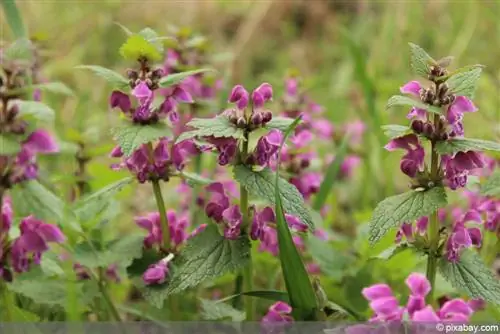
Once the gundel vine has spread, it can usually only be eliminated through regular weeding. Fortunately, the perennial plants can be pulled out of the ground quite easily by hand. Basically, the Gundermann is very annoying if you want a well-kept lawn, but otherwise it doesn't necessarily bother you. The creeping plant hardly poses a threat to he althy grass areas. However, the groundworm can become quite rampant if the grass does not form a closed hub. Frequent mowing of the lawn does not affect the weeds. On the contrary, this measure actually promotes its growth. Earth ivy reacts sensitively to frequent foot traffic. It is therefore mainly found in places where there is little “traffic”.
Systematic approach
Gundermann is a very stubborn plant. If residual pieces remain in the soil, new plants will grow from them and the plague will begin again after a while. In order to permanently and effectively remove these lawn weeds from the lawn, a single measure is not enough. Control is most effective if the gardener proceeds systematically and uses a combination of different methods.
Mechanical emergency measures
As long as the gundel vine does not spread excessively in the lawn, you should limit yourself to purely mechanical methods. As a rule, you can keep the plant under control relatively well this way. However, if it spreads a lot, this method requires a lot of effort, especially when it comes to large lawns. Nevertheless, even if there is a heavy infestation, it is necessary to first remove a large part of the weeds by hand (possibly with a rake).
- Time: all year round, best before seeds ripen
- otherwise you also have to take care of the seedlings
- is relatively easy to weed because of the shallow root system
- It's best to start with the mother plant
- First loosen heavy soils with the digging fork
- Take out the rosette
- then pull out the runners
- alternatively remove with a rake
- additional scarification
If you can't find the mother plant, carefully pull a runner. Since these always spread from a node (main plant), the runner will inevitably lead you to the origin of the plant at some point. The challenge is not to overlook any parts of the dense vegetation, as new plants can form from them.
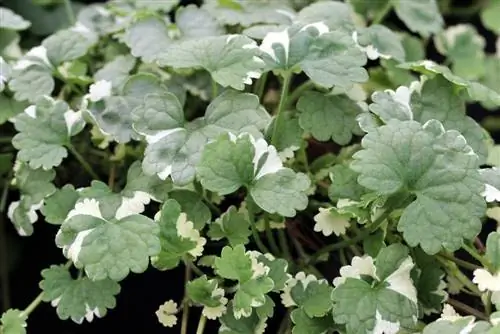
Tip:
Remove the lawn clippings immediately after mowing. But under no circumstances should you dispose of it in the compost, otherwise the Gundermann may spread further in the garden. The lawn should not be cut shorter than about four centimeters.
Change soil conditions
Although a large part of the Gundermann was removed after the lawn was manually cultivated, that doesn't mean that it will stay that way permanently. If the same conditions continue to prevail regarding the location and soil conditions, the unloved plant will come back after a short time. If you create optimal conditions for the grasses, weeds will find it difficult to gain a foothold. The Gundel vine is not a serious competitor for he althy, strong grass.
Preferred location conditions for the Gundel vine
Glechoma hederacea prefers certain location and soil conditions in order to establish itself and spread widely. It is considered an indicator plant for the following conditions:
- light shadow
- slightly moist
- heavy soil
- nutrient-rich (high nitrogen, phosphate and calcium supply)
- calcareous
- also grows in slightly acidic soil
Measures
As with many lawn weed problems, a long-term approach to control begins with a critical assessment of the lawn's site and soil conditions. In most cases, favorable conditions for the rampant weeds mean unfavorable conditions for the grasses. A combination of shade, wet soil and few nutrients works in the weeds' favor. For this reason, it is necessary to adhere to a few important rules in the future. Basically, earth ivy probably cannot be completely banned from the lawn. However, with a few simple tricks you can limit its spread.
- Scarify the lawn regularly
- Do not cut grass too short (minimum length 4-5 cm)
- For heavy soils, incorporate some sand or grit (immediately after scarifying)
- Avoid very shady areas next to/under dense hedges and trees
- If necessary, cut back trees a little (provides more light)
- Close gaps in the lawn with lawn seeds
- sow more shade-tolerant lawn varieties in shady locations
- Optimize soil pH value
- on light soil: pH 6.0
- on heavier soils: pH 7.0
You should also fertilize your lawn regularly. Although the nutrients do not help to drive away the Gundermann, they do strengthen the grasses so that additional weeds do not settle in them. However, be careful not to introduce high amounts of nitrogen into the soil, otherwise you will become an involuntary breeder of the gundel vine.
Tip:
Before applying fertilizer or changing the pH with lime or other means, you should send a soil sample to a laboratory and work based on the result. There are sets available from specialist retailers that can be sent in for as little as 20 euros.
Weed killer
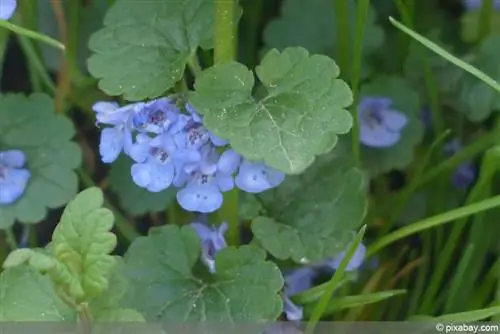
One way to remove Gundermann from the lawn is to use weed killers that are specially developed for grass areas. Treatment is carried out either by spraying or pouring using the shower attachment. Only lawn weed killers may be used in the lawn. The reason for this is as follows: The herbicides or combination products consisting of fertilizer and weed killer can distinguish between weeds and grasses, so there is no need to fear damage to the lawn. Whether the product is also effective against gundel vine is noted in the instructions for use or the package insert. If in doubt, seek advice from a specialist when purchasing so that incorrect use can be ruled out.
- Application period: May to October (preferably in spring or autumn)
- only effective against dicotyledonous plants
- Grasses are monocotyledonous plants
- always follow the instructions on the package carefully
- multiple application may be necessary
Most of the active ingredients in the herbicide are absorbed through the leaves, and a small part is also absorbed through the roots. The active ingredients are distributed throughout the entire plant and systematically damage it. After growth stops, the entire harmful plant finally dies.
Application
Lawn weed killers are commercially available in ready-to-use form (usually in a spray bottle) or as a concentrate that must be diluted with water before use. The product is then either sprayed directly onto the ground vines or poured using a watering can with a shower attachment. Warm, but not too hot, weather conditions accelerate the death of the gundel vine. The effect begins after just a few hours, but it only becomes visible a few days later when the plants die and turn brown.
For the weed killer to work well, there must be enough leaf mass. If lawns have just been mown, the weed leaves have of course also been removed, so the products cannot have a sufficient effect. Instead, wait a few days after mowing before applying the products.
Liquid products
- apply to dry plants
- ideally it should not rain for at least 6-8 hours after treatment
- use preferably in the evening
- Dew or rainwater leads to undesirable dilution
- pay attention to intensive wetting of the leaves
- the finer the jet/nozzle, the better the wetting is
- Minimum temperature: about 10 degrees
- Maximum temperature: about 25 degrees
- when spraying, only work on windless days
Combined products with fertilizer
- unlike liquid products, the leaves must be dewy
- possibly water a few hours before application
- alternatively use after a rain shower
Dead plants should be removed from the lawn with a rake after a few days. However, under no circumstances should you dispose of the plant residues in the compost or in organic waste, but rather in the residual waste. Wear gloves when working to avoid contact with herbicide residue.
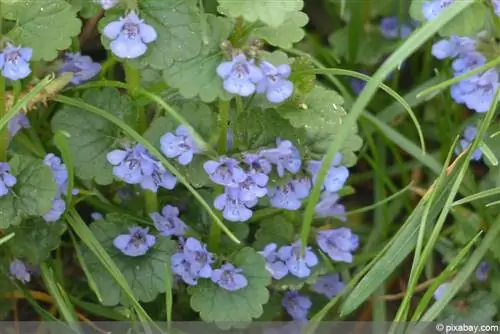
Security
Even if many of the herbicides are declared organic, they can pose a danger if handled incorrectly. Therefore, be sure to pay attention to your safety while using the herbicides.
- Leave children and animals in the house during treatment
- Wear gloves
- Wear protective clothing (long trousers, long sleeves, closed shoes) when spraying
- safety glasses or even a face shield may be necessary
- do not work in strong winds or temperatures above 25 degrees
- Do not inhale spray mist
- Watering broth or mist must not get onto neighboring ornamental or useful plants
- Keep your distance from bodies of water
Tip:
Entering the lawn is only allowed after it has dried. If you would like to use the lawn as a place to lie down or play, you will have to wait until the next time the lawn is cut.
Toxicity
While the gundel vine is considered edible for humans in small quantities and is also used as a medicinal plant, it is poisonous to many mammals. If you set up an outdoor enclosure on the lawn for your rodents or rabbits in summer, be sure to make sure in advance that it is free of groundworm.
Conclusion
Once the gundel vine has settled in the lawn, you can never really get rid of it. Herbicides will also be temporarily effective at best unless the conditions that originally led to the establishment of the unwanted weed are changed. A combination of weeding with judicious use of herbicides is one of the most effective and environmentally friendly methods.

